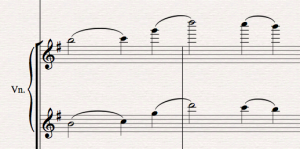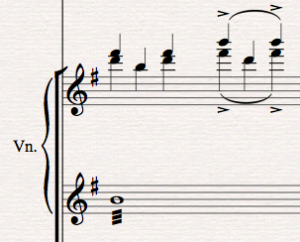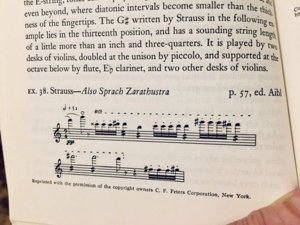Zedcars
Klaatu barada nikto
Hello,
I've just had a bit of a shock after I read (in an old notebook of mine) that even professional violin players cannot perform jumps bigger than a 3rd up to the very highest notes (say above high A). I have a piece I'm writing that I'm quite a long way towards finishing where I have the following 2 passages for Violins 1:


As you can see, the first one jumps from high G up a fifth to very high D. This is potentially the most problematic.
The second example is divisi (triplets), the upper part of which goes from F# up to high B down to D and back up to B.
Obviously this is for violin ensemble. Please could someone tell me if this is impractical? If so, I will have to re-think my score. Or if this is playable by a group? I've been unable to find any passages in the repertoire for very high strings in this context.
The only other instrument I have playing up there is a piccolo. If I were to have to re-score it, my only options I can see are 1) have Vn1 play in unison with Vn2 an octave lower (causing a dramatic loss of power in the top octave), or 2) go back to the drawing board and transpose my entire piece down a whole-tone (which will cause other problems and may still be too high anyway). 3) Have them play the melody as written, but play the high D note down 1 octave and allow the piccolo to cover the octave above. This will may ruin the line though.
My intention is to have my piece performed at some point.
I'd really appreciate any help and advice on this.
Edit: Forgot to add # to F# above.
I've just had a bit of a shock after I read (in an old notebook of mine) that even professional violin players cannot perform jumps bigger than a 3rd up to the very highest notes (say above high A). I have a piece I'm writing that I'm quite a long way towards finishing where I have the following 2 passages for Violins 1:


As you can see, the first one jumps from high G up a fifth to very high D. This is potentially the most problematic.
The second example is divisi (triplets), the upper part of which goes from F# up to high B down to D and back up to B.
Obviously this is for violin ensemble. Please could someone tell me if this is impractical? If so, I will have to re-think my score. Or if this is playable by a group? I've been unable to find any passages in the repertoire for very high strings in this context.
The only other instrument I have playing up there is a piccolo. If I were to have to re-score it, my only options I can see are 1) have Vn1 play in unison with Vn2 an octave lower (causing a dramatic loss of power in the top octave), or 2) go back to the drawing board and transpose my entire piece down a whole-tone (which will cause other problems and may still be too high anyway). 3) Have them play the melody as written, but play the high D note down 1 octave and allow the piccolo to cover the octave above. This will may ruin the line though.
My intention is to have my piece performed at some point.
I'd really appreciate any help and advice on this.

Edit: Forgot to add # to F# above.
Last edited:


 , reduced the upper players to 2 desks doubled with piccolo in the following famous piece:
, reduced the upper players to 2 desks doubled with piccolo in the following famous piece:
 Not a big deal.
Not a big deal.

